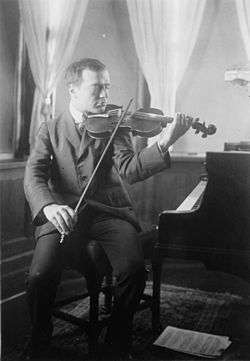Violin Concerto (Korngold)
Erich Wolfgang Korngold composed his Violin Concerto in D major, Op. 35, in 1945.
Instrumentation
Working in the lush, lyrical idiom reminiscent of fin de siècle Vienna, Korngold scored the concerto for elaborate instrumental forces. In addition to the solo violin, the concerto calls for two flutes (one doubling piccolo), two oboes (one doubling cor anglais), two clarinets, bass clarinet, two bassoons (one doubling double bassoon), four horns, two trumpets, trombone, harp, strings, as well as a colorful percussion section of timpani, bass drum, cymbals, gong, tubular bell, glockenspiel, vibraphone, xylophone, and celesta.
Movements
- Moderato nobile: The violin solo which opens the concerto is a theme from Another Dawn (1937), running over two octaves in five notes. Juarez (1939) provided the second theme, more expansive and reliant upon the orchestra.
- Romanze: A solo clarinet introduces the principal theme of the slow movement, quoted from Anthony Adverse (1936) and revisited after a contrasting middle section that seems to have been uniquely composed for the concerto.
- Allegro assai vivace: The most demanding movement for the soloist begins with a staccato jig, which leads to a second theme based on the main motif from The Prince and the Pauper (1937) and builds up to a virtuoso climax.
A typical performance lasts about 25 minutes.
Overview

Korngold had vowed to give up composing anything other than film music, with which he supported himself and his family, until Hitler had been defeated. With the end of World War II, he retired from films to concentrate on music for the concert hall. The Violin Concerto was the first such work that Korngold penned, following some initial persuasion from the violinist and fellow émigré Bronisław Huberman. Korngold had been hurt by the assumption that a successful film composer was one that had sold his integrity to Hollywood, just as earlier he had been hurt by many critics' assumptions that his works were performed only because he was the son of music critic Julius Korngold. He was thus determined to prove himself with a work that combined vitality and superb craftsmanship.[1]
The concerto was dedicated to Alma Mahler, the widow of Korngold's childhood mentor Gustav Mahler. It was premiered on 15 February 1947 by Jascha Heifetz and the St. Louis Symphony under conductor Vladimir Golschmann. It received the most enthusiastic ovation in St. Louis concert history.[2] On 30 March 1947, Heifetz played the concerto in Carnegie Hall with the New York Philharmonic conducted by Efrem Kurtz; the broadcast performance was recorded on transcription discs. The composer wrote about Heifetz's playing of the work:
In spite of the demand for virtuosity in the finale, the work with its many melodic and lyric episodes was contemplated for a Caruso than for a Paganini. It is needless to say how delighted I am to have my concerto performed by Caruso and Paganini in one person: Jascha Heifetz.[3]
Heifetz's performance launched the work into the standard repertoire, and it quickly became Korngold's most popular piece. However, the fame of the violin concerto, combined with Korngold's eminent association with Hollywood film music, has helped obscure the rest of his legacy as a composer of concert-hall works written before and after his arrival in the United States.[4]
Although Korngold was credited with introducing the sophisticated musical language of his classical training to the soundscapes of Hollywood films, a kind of reverse inspiration also occurred. Like many of Korngold's "serious" works in traditional genres, the violin concerto borrows thematic material from his movie scores in each of its three movements.[5]
Notable recordings
- Vilde Frang and James Gaffigan with the Frankfurt Radio Symphony
- Itzhak Perlman and André Previn with the Pittsburgh Symphony Orchestra
- Philippe Quint and Carlos Miguel Prieto with the Orquesta Sinfonica de Mineria
- Gil Shaham and André Previn with the London Symphony Orchestra
- Nikolaj Znaider and Valery Gergiev with the Vienna Philharmonic Orchestra
- James Ehnes and Bramwell Tovey with the Vancouver Symphony Orchestra
- Chantal Juillet and John Mauceri with the Berlin Radio Symphony Orchestra
- Jascha Heifetz and Alfred Wallenstein with the Los Angeles Philharmonic Orchestra
- Anne-Sophie Mutter and André Previn with the London Symphony Orchestra
- Laurent Korcia and Jean-Jacques Kantorow with the Orchestre Philharmonique de Liege
- Renaud Capuçon and Yannick Nézet-Séguin with the Rotterdam Philharmonic Orchestra
Notes
References
Steinberg, Michael, The Concerto, a listener's guide (Oxford and New York: Oxford University Press, 1998). ISBN 0-19-510330-0.
External links
- American Symphony Orchestra program notes, September 20, 1992
- National Symphony Orchestra program notes, February 3-5, 2005
- Sound Files (MP3) of The Japanese Premiere of Korngold:Violin Concerto (1989)